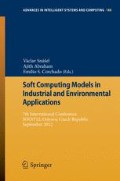Abstract
The present work show the model of regression based on intelligent methods. It has been created to obtain current extinction angle for a half wave controlled rectifier. The system is a typically non-linear case of study that requires a hard work to solve it manually. First, all the work points are calculated for the operation range. Then with the dataset, to achieve the final solution, several methods of regression have been tested from traditional to intelligent types. The model is verified empirically with electronic circuit software simulation and analytical methods. The model allows obtaining good results in all the operating range.
Access this chapter
Tax calculation will be finalised at checkout
Purchases are for personal use only
Preview
Unable to display preview. Download preview PDF.
References
Malvino, A.P., Bates, D.J.: Electronic principles. Recording for Blind & Dyslexic, Princeton (2008)
Hart, D.W.: Power Electronics. McGraw-Hill, New York (2011)
Rashid, M.H.: Power electronics handbook: devices, circuits, and applications. Butterworth-Heinemann, Burlington (2011)
Mohan, N.: Power electronics: a first course, Hoboken, N.J. (2012)
Coleman, T.F., Li, Y.: An Interior, Trust Region Approach for Nonlinear Minimization Subject to Bounds. SIAM Journal on Optimization 6, 418–445 (1996)
Coleman, T.F., Li, Y.: On the Convergence of Reflective Newton Methods for Large-Scale Nonlinear Minimization Subject to Bounds. Mathematical Programming 67(2), 189–224 (1994)
Levenberg, K.: A Method for the Solution of Certain Problems in Least-Squares. Quarterly Applied Mathematics 2, 164–168 (1944)
Marquardt, D.: An Algorithm for Least-squares Estimation of Nonlinear Parameters. SIAM Journal Applied Mathematics 11, 431–441 (1963)
Moré, J.J.: The Levenberg-Marquardt Algorithm: Implementation and Theory. In: Watson, G.A. (ed.) Numerical Analysis. Lecture Notes in Mathematics, vol. 630, pp. 105–116. Springer (1977)
Mark, J., Goldberg, M.: Multiple Regression Analysis and Mass Assessment: A Review of the Issues. Appraisal Journal 56(1), 89–109 (1988)
Do, A.Q., Grudnitski, G.: A Neural Network Approach to Residential Property Appraisal. The Real Estate Appraiser 58(3), 38–45 (1992)
Larsen, J.E., Peterson, M.O.: Correcting for Errors in Statistical Appraisal Equations. The Real Estate Appraiser and Analyst 54(3), 45–49 (1988)
Limsombunchai, V., Gan, C., Lee, M.: House Price Prediction: Hedonic Price Model Vs. Artificial Neural Network. American Journal of Applied Sciences 1(3), 193–201 (2004)
Worzala, E., Lenk, M., Silva, A.: An Exploration of Neural Networks and Its Application to Real Estate Valuation. Journal of Real Estate Research 10, 185–202 (1995)
Guan, J., Levitan, A.S.: Artificial Neural Network Based Assessment of Residential Real Estate Property Prices: A Case Study. Accounting Forum 20(3/4), 311–326 (1997)
Taffese, W.Z.: Case-Based Reasoning and Neural Networks for Real Estate Valuation. In: Proceedings of 25th International Multi-Conference: Artificial Intelligence and Applications, Innsbruck, Austria, pp. 84–89 (2007)
Guan, J., Zurada, J., Levitan, A.S.: An Adaptive Neuro-Fuzzy Inference System Based Approach to Real Estate Property Assessment. Journal of Real Estate Research 30(4), 395–420 (2008)
Peterson, S., Flanagan, A.B.: Neural Network Hedonic Pricing Models in Mass Real Estate Appraisal. Journal of Real Estate Research 31(2), 147–164 (2009)
Bishop, C.M.: Pattern recognition and machine learning. Springer, New York (2006)
Cristianini, N., Shawe-Taylor, J.: An Introduction to Support Vector Machines. Cambridge University Press, Cambridge (2000)
Ye, J., Xiong, T.: Svm versus least squares svm. In: The 11th International Conference on Artificial Intelligence and Statistics (AISTATS), pp. 640–647 (2007)
Yankun, L., Xueguang, S., Wensheng, C.: A consensus least support vector regression (LS-SVR) for analysis of near-infrared spectra of plant samples. Talanta 72, 217–222 (2007)
De Brabanter, K., Karsmakers, P., Ojeda, F., Alzate, C., De Brabanter, J., Pelckmans, K., De Moor, B., Vandewalle, J., Suykens, J.A.K.: LS-SVMlab Toolbox User’s Guide version 1.7 (2010), http://www.esat.kuleuven.be/sista/lssvmlab/
Xavier de Souza, S., Suykens, J.A.K., Vandewalle, J., Bolle, D.: Coupled Simulated Annealing. IEEE Transactions on Systems, Man and Cybernetics - Part B 40(2), 320–335 (2010)
Cleveland, W.S., Devlin, S.J.: Locally weighted regression: An approach to regression analysis by local fitting. Journal of the American Statistical Association 83, 596–610 (1988)
Duda, R.O., Hart, P.E., Strork, D.G.: Pattern Classification, 2nd edn. Wiley, Chichester (2001)
David, J., Henao, V.: Neuroscheme: A modeling language for artificial neural networks. Dyna-Colombia 147, 75–82 (2005)
Author information
Authors and Affiliations
Corresponding author
Editor information
Editors and Affiliations
Rights and permissions
Copyright information
© 2013 Springer-Verlag Berlin Heidelberg
About this paper
Cite this paper
Calvo-Rolle, J.L., Quintián, H., Corchado, E., Ferreiro-García, R. (2013). Intelligent Model to Obtain Current Extinction Angle for a Single Phase Half Wave Controlled Rectifier with Resistive and Inductive Load. In: Snášel, V., Abraham, A., Corchado, E. (eds) Soft Computing Models in Industrial and Environmental Applications. Advances in Intelligent Systems and Computing, vol 188. Springer, Berlin, Heidelberg. https://doi.org/10.1007/978-3-642-32922-7_26
Download citation
DOI: https://doi.org/10.1007/978-3-642-32922-7_26
Publisher Name: Springer, Berlin, Heidelberg
Print ISBN: 978-3-642-32921-0
Online ISBN: 978-3-642-32922-7
eBook Packages: EngineeringEngineering (R0)

